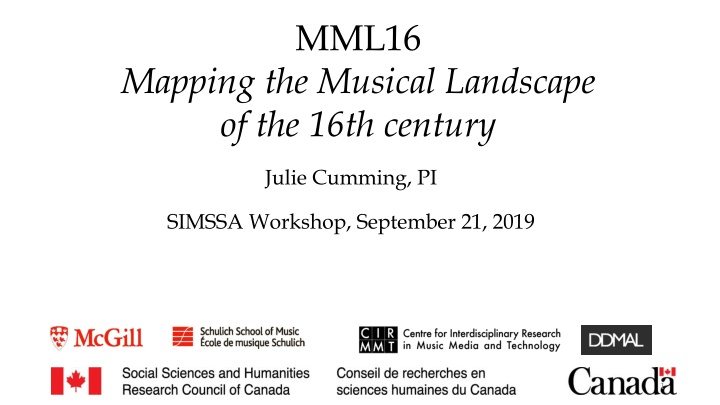
Mapping the Musical Landscape of the 16th Century with SSHRC Insight Grant
Explore the 16th-century musical landscape through a collaborative project funded by the SSHRC Insight Grant. Discover how scholars track music across space and time using inventories, databases, optical music recognition, and collaborative efforts with RISM. Join the conversation on polyphonic music and delve into the vibrant world of musical manuscripts and prints.
Download Presentation

Please find below an Image/Link to download the presentation.
The content on the website is provided AS IS for your information and personal use only. It may not be sold, licensed, or shared on other websites without obtaining consent from the author. If you encounter any issues during the download, it is possible that the publisher has removed the file from their server.
You are allowed to download the files provided on this website for personal or commercial use, subject to the condition that they are used lawfully. All files are the property of their respective owners.
The content on the website is provided AS IS for your information and personal use only. It may not be sold, licensed, or shared on other websites without obtaining consent from the author.
E N D
Presentation Transcript
MML16 Mapping the Musical Landscape of the 16th century Julie Cumming, PI SIMSSA Workshop, September 21, 2019 1
SSHRC Insight Grant, 2019-2024 $340,000 Collaborators Laurent Pugin, RISM Switzerland Andrew Hankinson, Bodleian Library, Oxford, and DIAMM Jane Hatter, U of Utah Remi Chiu, Loyola University, Baltimore Daniel Donnelly, U of Toronto, OISE Jenn Riley, McGill Libraries Co-investigators Ichiro Fujinaga, McGill Cory McKay, Marianopolis Peter Schubert, McGill Genevi ve Bazinet, U of Ottawa 2
Studying the musical landscape How do we track the way music moves across space and time? Through study of the prints and manuscripts in which the music survives. Searchable online database including inventories of all the surviving prints and manuscripts of polyphonic music in the sixteenth-century The inventories will link to online images, and include metadata on: Genres, dates, provenance, current location, and type of source Scholars will be able to contribute their own inventories For the first time all the inventories will be able to speak to each other A Cantus Database for Polyphonic Music 3
Types of searches (could use RDF) All the pieces in a single source (sortable by genre and composer) All the sources of a single piece (sortable by date, format, print or manuscript, etc.) All the motets found in Italian prints between 1560 and 1575 Pieces found in both Italian (Catholic) and German (often Protestant) sources 4
Optical music recognition for mensural notation Already beginning (Martha Thomae, Laurent Pugin, and Jorge Calvo-Zaragoza and David Rizo) Automated incipits (for disambiguation of pieces with the same title) Automated transcription from images of original sources Searchable symbolic notation Performable scores 5
Collaboration with RISM Discussions have begun with Klaus Pietschmann Laurent Pugin Jennifer Ward We ve begun by comparing the fields in different catalogues: RISM: print and online (Muscat) DIAMM The Census Catalogue H. M. Brown s Instrumental Music Printed before 1600 6
Research themes: Musical border crossings Crossing the confessional divide: music shared by Catholics and Protestants European music abroad (sources containing European music outside Europe) The lighter side of the madrigal: the lighter Italian genres, their regional origins, and their dissemination outside of Italy Sacred and secular: masses and magnificats modeled on secular works (why and how were French chansons, Italian madrigals, and German songs used as the basis for sacred music?) Each theme provides a window into how music functioned in the past, and also has parallels in modern society. 7
Thank you! And special thanks to Leah Weitzner (McGill undergrad RA for the summer) Emily Hopkins, SIMSSA project manager 8






















